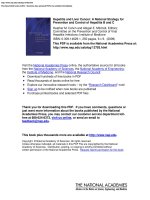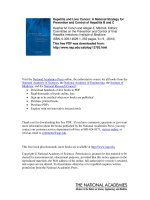DEVELOPMENT STRATEGY FOR POST AND TELECOMMUNICATION TECHNOLOGY OF OPTICAL FIBER AND EQUIPMENT JSC
Bạn đang xem bản rút gọn của tài liệu. Xem và tải ngay bản đầy đủ của tài liệu tại đây (5.28 MB, 104 trang )
DEVELOPMENT STRATEGY
FOR POST AND
TELECOMMUNICATION
TECHNOLOGY OF OPTICAL
FIBER AND EQUIPMENT JSC
(TFP)
1
PART 1: Introduction...................................................................................................................5
1. Rational.................................................................................................................................5
2. Thesis objective....................................................................................................................6
3. Study scope...........................................................................................................................6
4. Study methodology...............................................................................................................6
PART 2: CONTENT.....................................................................................................................8
CHAPTER 1: GENERAL THEORY.......................................................................................8
1.1. Strategic management ...................................................................................................8
1.1.1. What is strategy?.....................................................................................................8
1.1.1.1 Views on strategic management.......................................................................8
1.1.1.2. Definitions of strategy .....................................................................................9
1.1.2. Strategic management ..........................................................................................10
1.1.2.1. Definition of strategic management ..............................................................10
1.1.2.2. The necessity of strategic management in the company ...............................11
1.1.2.3. Process of strategic management...................................................................13
1.2. Structural analysis of the competitive environment ....................................................17
1.3. Selecting development strategy ..................................................................................25
1.3.1. Generic strategies..................................................................................................25
1.3.2. Strategic development directions..........................................................................27
CHAPTER 2: STRATEGIC MANAGEMENT ANALYSIS IN POST AND
TELECOMMUNICATION TECHNOLOGY OF OPTICAL FIBER AND EQUIPMENT
JSC .........................................................................................................................................29
A. External factor analysis......................................................................................................29
2.1. Macro environment analysis........................................................................................29
2.1.1. Global financial crisis and world economic downturn.........................................29
2.1.2. The position, role and development orientation of telecommunication industry in
Vietnam economy...........................................................................................................37
2.2. Vietnam Optical Fiber Production Industry Analysis..................................................40
2.2.1. Overview of Vietnam optical fiber production industry.......................................40
2.2.2. Competitor analysis..............................................................................................41
2.2.3. Buyer position.......................................................................................................42
2.2.4. Material supplier position.....................................................................................43
2.2.5. Substitute products................................................................................................43
2.3. Opportunities and threats for TFP ...............................................................................44
2.3.1. Opportunities ........................................................................................................44
2.3.2. Threats...................................................................................................................45
B. Internal factor analysis.......................................................................................................46
2.4. History of TFP.............................................................................................................46
2.5. TFP's mission...............................................................................................................47
2.6. Organization structure..................................................................................................47
2.7. The production of TFP.................................................................................................50
2.7.1. Production process and quality control:................................................................50
2.7.2 TFP Production Capacity ......................................................................................54
2.7.2.1. Technical capacity.........................................................................................54
2.7.2.2. Technology capacity......................................................................................54
2.7.2.3. Human resources capacity.............................................................................55
2
2.7.3. TFP products.........................................................................................................56
2.7.3.1. Optical cable .................................................................................................56
2.7.3.2. Post and telecommunication equipments and accessories.............................56
2.8. Sales and profit............................................................................................................74
2.9. Marketing.....................................................................................................................76
2.9.1. Price Policy...........................................................................................................76
2.9.2. Distribution network.............................................................................................79
2.10. TFP finance status......................................................................................................80
2.10.1. Liquidity ratios:...................................................................................................85
2.10.1.1. Current ratio.................................................................................................85
2.10.1.2. The quick ratio.............................................................................................85
2.10.1.3. Inventory to Net Working Capital...............................................................86
2.10.1.4. Cash ratio.....................................................................................................86
2.10.2. Profitability ratios...............................................................................................86
2.10.2.1. Net Profit Margin.........................................................................................87
2.10.2.2. Gross Profit Margin.....................................................................................87
2.10.2.3. Return on Assets (ROA)..............................................................................88
2.10.2.4. Return on Equity (ROE)..............................................................................88
2.10.3. Activity ratios......................................................................................................89
2.10.3.1. Inventory turnover.......................................................................................89
2.10.3.2. Day of inventory ratio..................................................................................90
2.10.3.3. Net working capital turnover.......................................................................90
2.10.3.4. Asset turnover ratio......................................................................................90
2.10.3.5. Fixed asset turnover ratio.............................................................................90
2.10.3.6. Average collection period:...........................................................................91
2.10.3.7. Account receivable turnover........................................................................92
2.10.3.8. Days of cash.................................................................................................92
2.10.4. Leverage ratio.....................................................................................................92
2.11. Identifying strengths, weaknesses of TFP.................................................................93
CHAPTER 3: FORMULATING DEVELOPMENT STRATEGY FOR TFPCONCLUSION AND RECOMMENDATIONS...................................................................95
3.1. Formulating development strategy for TFP.....................................................................95
3.1.1. Foundations of TFP’s strategy..................................................................................95
3.1.1.1. What is to be satisfied? (Customer needs and product differentiation).............95
3.1.1.2. Who is to be satisfied? (Customer groups and market segmentation)...............95
3.1.1.3. How customer needs are to be satisfied? (Distinctive competences)................96
3.1.2. Strategic options for TFP..........................................................................................96
3.1.2.1. Generic competitive strategies and a recommended strategy for TFP..............96
a. Cost leadership strategy..........................................................................................97
b. Differentiation strategy...........................................................................................97
c. Focus strategy..........................................................................................................98
3.1.2.2. Directions for TFP’s strategy development.......................................................98
3.1.2.3. Methods for TFP’s strategy development..........................................................99
3.2. Conclusion.......................................................................................................................99
3.3. Recommendations......................................................................................................100
3.3.1 Organization structure..........................................................................................101
3
3.3.2. Products...............................................................................................................101
3.3.3. Product price.......................................................................................................101
3.3.4. Advertisement and promotion activities.............................................................102
3.3.5. Financial recommendations................................................................................102
References.................................................................................................................................103
4
PART 1: Introduction
1. Rational
After 20 years of renovating Post, Telecommunication and Information
Technology industry, Vietnam has had comprehensive and great step forward,
improved capacity, modernized continuously, shortened the development gap in
comparison with other countries in the region and the world, integrated actively in the
international economy, ensured security and national defense for the country
modernization and industrialization.
Post, Telecommunication and Information Technology industry which now is
Vietnam Information Technology and Communications industry has made great
development step. Telephone density is almost 50% (surpassing the target of 35% set
by the X National Party Congress), 100% communes have telephones, internet users are
more than 20 % of the population, the average radius of post office reduced to less than
2.3 km. Most of state agencies and more than 50% of private companies having applied
information technology. The rate of state officers using information technology and
internet skillfully in the central agencies is 70%. Information technology has developed
with higher speed day by day. Hardware industry development speed is 20-30% on the
average. Software and service industry has a development speed of 30-40%. Many
world leading information technology and communication corporations have enter
Vietnam market and created many favorable conditions. Information technology and
communication contributes an important part in improving management capacity,
business and production, poverty reduction, digital gap shortening, national information
security and safety insurance. It’s necessary to mention the great contribution of the
post equipment and telecommunication material production and supplying industry in
the whole industry success.
Having been established in May 2007, Post and Telecommunication Technology
of Optical Fiber and Equipment JSC (TFP) is one of the leading units in producing and
5
supplying optical in Vietnam market. With the favorable location in the industrial
production zone of Vietnam Post and Telecommunication Corporation (Dốc Vân - Yên
Viên - Gia Lâm - Hà Nội), the European comprehensive production line which is the
most modern one in Vietnam now, the company has the capacity to produce and supply
more than 15,000 km optical cable/year in the market. The optical cable types that the
company produce are: duct fiber cable, figure 8 cable, electricity attaching cable, direct
buried cable, telecommunication accessing cable; family connecting cable. Moreover,
the company also supplies accessories like: incandescent gas-lamp, ODF, patch cord
and pigtail… TFP is gradually proving its brand name in domestic and international
market with the quality of each product.
2. Thesis objective
This thesis aims at formulating a development strategy for TFP especially with
the following orientations:
Defining strengths, weaknesses as well as opportunities and threats that
TFP will have to face.
Evaluating TFP's current strategy
Formulating a long term development strategy for TFP
3. Study scope
This is the study of TFP only, especially of telecommunication optical cable
products which are the main products of TFP. The thesis is a systematic presentation of
TFP's long term development strategy.
The thesis is the outcome of analyzing and evaluating available data of Vietnam
economy, telecommunication industry in general and TFP's information.
4. Study methodology
The study was conducted according to the below diagram:
6
External
influencing factor
evaluation
Competition factor
consideration
Internal
influencing factor
consideration
Opportunities,
threats
Current result
evaluation
Strengths,
weaknesses
FORMULATING, EVALUATING AND SELECTING THE BEST STRATEGY
CONCLUSION AND RECOMMENDATION
Study diagram
7
PART 2: CONTENT
CHAPTER 1: GENERAL THEORY
1.1. Strategic management
Strategic management is a fast-developing field of study. It looks at the
corporation as a whole and attempts to explain why some firms develop and thrive
while others stagnate and go bankrupt. Strategic management typically focuses on
analyzing the problems and opportunities faced by people in top management. Before
mentioning in detail about the process of strategic management, specially the strategy
formulation stage, firstly, we try to answer the question: “What is strategy?”
1.1.1. What is strategy?
1.1.1.1 Views on strategic management
There are in fact many different views on strategic management. It depends on
the different study purpose and different development period in which economists have
different views on strategy.
According to General Ailleret, strategy is “identifying ways and applied tools to
achieve goals defined by policies”.
F.J.Gouillart said that the strategy of businessmen is “the whole decisions aimed
at winning important positions, defending and creating results which can be exploited
and used immediately”.
“Strategy is the art of coordinating controlling activities to achieve long term
goals” (G. Hissh).
“The strategy of companies is to outline the long term and sustainable
development orbit around which accurate decisions and actions of companies can be
arranged” ( Alain Charlec Martinet).
8
Some economists in the world has unified the business strategy with company
development strategy. Representatives for this view are BCG economist who said that
“the development strategy is the general strategy of companies including parts of the
secondary strategies of marketing, finance, research and development etc.”
However, for M. Parter and K. Ohmac, the purpose of business strategy is to
create the most favorable conditions to make the competitive advantages for companies.
According to the common approach, strategy is a system of long term objectives,
policies and major measures for production and business in terms of finance, human
resources to make the company one step forward.
1.1.1.2. Definitions of strategy
From different definitions of strategy, we can draw from those the most common
definition of strategy as follows:
Strategy is a system of view points, purposes and basic objectives together with
solutions and policies aiming at using the best resources, advantages, opportunities of
the company to achieve the objective set in a certain period.
Business strategy has the features of:
- Business strategy is the overall company strategy which defines objectives and
business directions for a relatively long term period (5-10 years) and is fully understood
in all production and business activities of the company to ensure that the company will
develop sustainable.
- Business strategy only outline the long term orientation and is for orientation
only. In the actual practice, business should be conducted with a combination of
strategic objectives and the situational objectives, strategy and tactics, long term and
short term objectives. After that it’s possible to ensure the business results and
overcome mistakes caused by strategy.
9
- All the important decision during the strategy formulation, selection,
preparation, monitoring and evaluation should be made by the top manager of the
company. This ensures the accuracy of long term decisions and information
confidentiality.
- The business strategy is always made based on the competitive advantages. It
requires that in the strategy formulation, the company should evaluate correctly its
actual business and production situation to find out the strengths, weaknesses and
frequently review the internal factors during strategy implementation.
- Business strategy is first and foremost made for business areas, specialized
businesses, and traditional strengths of the company. This put the company in a position
where it should make, select and implement the strategy as well as do the business in
existing markets where it has strengths.
1.1.2. Strategic management
1.1.2.1. Definition of strategic management
“Strategic management” is a rather new concept and is not as popular as
“strategy” concept. Similar to strategy, there are many different views on strategic
management.
“Strategic management is the
management process of pursuing an
organization’s functions and responsibilities while managing the relations to its
environment.”.
According to this view point, strategic management is to make the company
work in the orientation of the environment, exploit opportunities, avoid risks to
complete the functions and responsibilites of the company.
“Strategic management is a combination of the management view points and
acts, deciding the permanent success of the company”.
10
This view point shows that the managers should define correctly the company’s
objectives and use the organisation’s resources better.
“Strategic management is the combination of decisions and action measures
leading to the planning and implementation of strategies to achieve the organisation’s
objectives”.
From the above view points on strategic management, we can have the following
definitions:
- Strategy is the study process of both current and future environments, the
planning of organisation’s objectives; the formulation, implementation and monitoring
the decision implementation for achieving those objectives in the current and future
environments.
Therefore, strategic management analyzes internaal and external conditions of
the company. Thanks to this, the company’s strengths and weaknesses can be defined to
take advantage of external opportunities and mitigate internal problems.
1.1.2.2. The necessity of strategic management in the company
Strategic management increasingly proves its role to the existence and
development of the company. A company without strategic management will often
orient its plans by resources analysis and plannings with assumption that the
environment context is stable and the long term plan will have many shortcomings. So
in the increasingly severe competitive environment, the company will fail and can’t be
flexible in adapting to the environment activities. A good strategic management will
bring many to the company opportunities and make it be active in gaining the
competitive advantage.
Strategic management has special importance to the survival of company.
- Strategic management helps the company to see clearly its goals and direction.
The company with clear defined goals and direction will help both managers and staff
to know and fully understand what to achieve and what needs to be done for the
11
success. With the direction and goals, company leaders will find it more easy in short
term plan making and implementation. Strategic management will help the whole
company to know where they are and how far they have gone on the way to their goals.
- Any organisation operatates in its environment and so does company. The
environment conditions always change. Environment changes always cause new
changes and threats to company, especially sudden opportunities and threats when the
environment changes quickly. The problem is how to exploit opportunities and
overcome threats in such a changing environment. Company managers can define in
advance opportunities and threats with strategic management. The strategic
management always care about the future. The strategic management forces the
company managers to analyse and forecast the environment conditions in the future and
from which the company can imagine and forecast the future to grasp opportunities the
best, make the most of opportunities and mitigate threats’ impacts. Companies applying
strategic management often have ability to gain active position toward the changes of
the environment. On the contrary, companies not applying strategic management
always make decision passively which means they only act after the environment has
changed.
- Strategic management helps company to implement the strategy with plans to
complete objectives the most effectively. Strategic management will coordinates and
unifies closely divisions and resources of the company to reach objectives. Strategic
management will reduce overlapping among divisions, allocate resources more
appropriately, operate, supervise and control more easily.
In summary, strategic management nowsaday has become an important part of
corporate management. Without strategy and strategic management, company will
operate with dispersion and overlapping and no action framwork at all. Therefore, it’s
difficult for them to survive permanently to reach the objectives.
However, company will only be successful when it has good strategic
management ability. If the strategic management process is not appropriate, the
12
company can move in the opposite direction with the objectives and wrong way with
the requirements.
Most of companies nowsaday only formulate strategies and don’t focus much on
strategy implementation. Strategy formulation is the most important stage of strategic
management process. However, the strategy is only what on paper if the
implementation is not good.
On the other hand, to formulate the strategy management process, company need
lots of time and efforts. Taking long term benefits into consideration, companies still
have to apply strategic management.
1.1.2.3. Process of strategic management
The process of strategic management involves 3 basic stages: (1) strategy
formulation, (2) strategy implementation, and (3) evaluation and control. Different
stages of the strategic management process at business level are visualized by the
Strategic Management Model in Figure 1.1.
13
External
Environment
Strategy Implementation
Strategy Formulation
Evaluation
& Control
Mission
Task
Environment
Societal
Environment
Objectives
Strategy
Programs
Internal
Environment
Budgets
Decisions
Actions
Structure
Culture
Resources
Performance
Figure 1.1: Strategic Management Model
Based on the context of this study, the focus will be on the strategy formulation
process.
Strategy formulation is often referred to as strategic planning or long-range
planning. Regardless of the term used, the process is primarily analytical, not actionoriented. As shown in the Strategic Management Model, the formulation process is
concerned with developing a corporation’s mission, objectives, strategy, and policies.
In order to do this, corporate strategy makers must scan both the external and internal
environments for needed information on strategic factors.
The first six steps commonly found in strategy formulation are a series of
interrelated activities:
1. Evaluation of:
a. the corporation’s current performance results in terms of return on investment,
profitability, etc., and
14
b. the corporation’s current mission, objectives, strategies, and policies.
2. Examination and evaluation of the corporation’s strategic managers - board of
directors and top management.
3. Scanning of the external environment to locate strategic opportunities and threats.
4. Scanning of the internal corporate environment to determine strategic strengths and
weaknesses.
5. Analysis of the strategic factors from step 3 and 4 to
a. pinpoint problem areas, and
b. review and revise the corporate mission and objectives as necessary.
6. Generation, evaluation, and selection of the best alternative strategy appropriate to
the analysis conducted in step 5.
(Source: Wheelen / Hunger, 1988)
The above strategy formulation process can be divided into 2 substages, as
illustrated in Figure 1.2:
15
Scan external
environment
Evaluate
current
performance
results
Examine and evaluate
the current
Mission
Objective
Strategies
Policies
Evaluate
strategic
managers
Analyze the competitive
environment
Entry
Buyers
Suppliers
Substitutes
Competitors
Scan internal
environment
S I T U A T I O N
Opportunities
Threats
Analyze
strategic factors
in light of
current situation
Strengths
Weaknesses
A N A L Y S I S
GENERATION, EVALUATION, AND SELECTION OF THE BEST
STRATEGY
Figure 1.2
Strategy formulation process (Source: Wheelen / Hunger,
1988)
16
Develop:
Mission
Objectives
• The first substage is the situation analysis. Beginning with an evaluation of
current performance and ending with the review and possible revision of mission
and objectives, this substage includes step 1 through 5.
• The second substage is the process of generation, evaluation, and selection of
the best alternative strategy. This substage is step 6.
In order to construct an appropriate competitive strategy, a “picture” of the
competitive environment is always a useful basic. In other words, there is clearly a
need for competitive environment analysis, an industry structure analysis.
1.2. Structural analysis of the competitive environment
Competitive environment analysis or Industry analysis is an important skill
related to the environmental scanning step in the strategic management process.
Periodically, managers need to develop a formal comprehensive analysis - a strategic
industry analysis. The analysis includes an overview of strategic forces affecting a
target industry, an analysis of various companies in the industry, forecasts and
recommendations.
A formal strategic industry analysis is useful in management and planning
positions. It helps managers understand their company’ s current strategic position.
Specifically, it should define the scope and direction of competitor actions so that the
company could focus and target. It should pinpoint and analyze the general threats and
opportunities facing all the companies in an industry. This can provide an advantage
for managers to respond appropriately, to catch timely the available opportunities while
minimizing or avoiding the threats facing firms in the industry. The strategic industry
analysis aids managers in deciding whether to enter or leave a particular industry.
17
Finally, it aids managers in understanding the strategies and behavior of specific
competitors.
A useful guide for strategic industry analysis is provided by Porter. He created a
model, calling it the five forces model of competition, as a strategic management
technique for established profit-seeking companies, as shown in Figure 2.3. This is
essentially a structural method of examining an organization or industry in order to
provide a clear understanding of the factors that affect a business. Porter argues that
“competition in an industry is rooted in its underlying economics, and competitive
forces exist that go well beyond the established combatants in a particular industry”
(Porter, 1980). He further suggests that to compete effectively a company should strive
to find a position where it is best able to defend itself against these competitive forces
or can influence them in its favor. So, the task of the strategist is to determine which of
these forces are of greatest importance to the organization and which can be influenced
by the strategic decisions of management. Each of these forces is now considered in
greater detail.
1. The Threat of Entry
New entrants to an industry tend to make it more competitive. The additional
competitiveness may be due to a number of factors including: the additional capacity
which they bring with them, their attempts to build market share, or increased costs due
to the building up of the costs of the factors of production.
However, the effects of new entrants materialize, it is frequently in the interests
of existing competitors to deter potential new entrants by making their prospects look
as unattractive as possible. This can be done in two major ways - through the erection
of barriers to entry and or through the threat of severe retaliation.
Clearly, it is in the interests of existing firms to have as high entry barriers as
possible. Porter (McNamee, 1987) lists major barriers to entry which are:
18
• Economies of scale
• Product differentiation
• Capital requirements
• Switching costs
• Access to distribution channel
• Cost disadvantages independent of scale, for example: proprietary knowledge,
etc.
• Government policy.
19
POTENTIAL ENTRANTS
Threat of
Entrants
COMPETITIVE
RIVALRY
SUPPLIERS
Bargaining
Power
BUYERS
Bargaining
Power
Threat of
Substitutes
SUBSTITUTES
Figure 1.3
A model for Industry Structural Analysis
(Source: Porter, 1980)
The importance of entry barriers to strategic planning can be illustrated by two
contrasting examples as follows:
The U.K aircraft engine manufacturer Rolls Royce has erected around it
substantial entry barriers in the form of economies of scale, product differentiation,
capital requirements, switching costs, proprietary knowledge, experience advantages
and government support. It seems extremely unlikely that the threat of new entrants
pose a threat to this company. The competitive threat that Rolls Royce faces come from
other quarters.
20
By way of contrast, an “industry” that has grown rapidly in the early 1980s and
which faces continuous threats from new entrants, because of the extremely low entry
barriers, is retail domestic video rental libraries. In this industry, many small
independent entrepreneurs with limited resources have opened such business. They
have been able to do so because of the low entry barriers: low capital requirements,
low switching costs, immediate distribution and no major economies of scale being
possible.
(Source: Johnson / Scholes, 1993)
2. The Power of Buyers
Buyers can be viewed as a competitive threat when they force down prices or
when they demand higher quality and better service (which increases operating costs).
Whether buyers are able to make demands on a company depends on their power
relative to that of the company. According to Porter, buyers are most powerful in the
following circumstances:
• Buyers are few in number and large relative to sellers
• Buyers purchase in large quantities.
• The supply industry depends on them for a large percentage of its total orders.
• Buyers can switch orders between supply companies at a low costs, thereby
playing off companies against each other to force down prices.
• It is economically feasible for them to purchase the input from several
companies at once.
• Buyers have the potential for backward integration.
• The buyers’ product is not strongly affected by the quality of the suppliers’
product
21
• The buyer has full information.
(Source: Hill / Jones, 1989)
3. The Power of Suppliers
Powerful suppliers can have the same adverse effects upon profitability as
powerful buyers. The big difference is the sources of their power - it is really the
opposite of the sources of buyer power. Thus suppliers tend to be powerful when the
following conditions obtain:
• There are few of them.
• There are few substitutes.
• The industry supplied is not an important customer
• The suppliers’ product is an important component to the buyer’ s business
• The supplier’s product is differentiated
• Suppliers can integrate forward.
4. The Threat of Substitutes
Substitutes, or alternative products that can perform the same function, limit the
price that an industry can charge for its products. Substitutes are not always perceived
by an industry to be present, and indeed may only be noticed when it is too late to
arrest their dominance. One typical example, which illustrates the rise of a substitute
product, is the current increasing proliferation of low cost microcomputers plus low
cost easy to use business packages in such areas as accounting, data base management
and word processing. This “product” has adversely affected the “industry” of specialist
programmers and specialist computer bureaus. It seems likely that this trend will
continue.
22
5. The Extent of Competitive Rivalry
Competitors will also be concerned with the degree of rivalry between
themselves in their own industry. How intense is this competition? What is it based on?
Is it likely to increase or decrease in intensity? How can it be reduced? All these are
questions which need to be thought about in the process of strategic analysis. The
degree of rivalry is likely to be based on the following:
• The extent to which competitors in the industry are in balance. What ever their
number, where competitors are of roughly equal size there is a danger of intense
competition as one competitor attempts to gain dominance over another.
Conversely, the most stable markets tend to be those with dominant organizations
within them.
• A market in slow growth - particularly one which is entering its maturity stage
and where competitors are keen to establish themselves as market leaders - is likely
o be high competitive.
• High fixed costs in an industry, perhaps through high capital intensity or high
costs of storage, are likely to result in competitors cutting prices to obtain the
turnover required. This can result in price wars and very low margin operations.
• If the addition of extra capacity is in large increments then the competitor
making such an addition is likely to create at least short term over-capacity and
increased competition.
• Again the importance of differentiation is clear. If a product or service is not
differentiated then there is little to stop customers switching between competitors,
which in turn raises the degree of rivalry between them. This is sometimes referred
to as a “commodity market” situation.
23
• Where there are high exit barriers to an industry, there is again likely to be the
persistence of excess capacity and consequently increased competition. (Source:
McNamee, 1987)
A reflection on the combined impact of exit and entry barriers on the
profitability of an industry is presented in Table 2.1.
Table 1.1
High
Low
High
High but possibly
High and stable
unstable profit
profit
Low
BARRIE
ENTRY
EXIT BARRIERS
Low and unstable
Low and stable
profit
profit
The impact of entry and exit barriers over industry profitability
(Hax / Majluf, 1991)
In conclusion, it is in the context of the above five dimensional competitive
environment that strategic decisions should be made. The context for each firm and
industry tends to be different and therefore the types of strategic action necessary for
success will be shaped by the overall industry structure. Therefore, one of the first
steps in strategic analysis should be an industry structure analysis, with the objective of
locating the firm in its competitive environment. Henderson (Ansoff, 1987) made a
similar point about the importance of the competitive environment when he talked
about Competitive Mapping. He has suggested that companies will only be able to
evolve effective strategies after they have plotted their own and their competitors’
24
locations on a competitive map. Once an individual company has done this, then its
strategy should be to move against the weakest sectors in its competitive map.
1.3. Selecting development strategy
As soon as completing the tasks of identification of the most relevant
competitors, of selection of the critical success factors and of developing a competitive
profile, companies have to select a strategy that is most appropriate for their
development. Options about development strategies involve decisions about three
elements that are depicted in Figure 2.5.
DEVELOPMENT STRATEGIES
What basis?
How?
Which
direction?
ALTERNATIVE
DIRECTIONS
Withdrawal
Consolidation
Market penetration
Product development
Market development
Diversification
related
unrelated
GENERIC
STRATEGIES
Cost leadership
Differentiation
Focus
ALTERNATIVE
METHODS
Internal development
Acquisition
Joint
development/alliances
Figure 1.5 Development strategies
(Source: Johnson / Scholes, 1993)
1.3.1. Generic strategies
According to Porter, the competitive strategies will be designed based on the
choice from three basic competitive approaches: cost leadership, differentiation, and
focus (Porter, 1985). These strategies are shown in Table 2.2.
25









